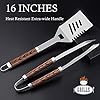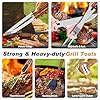TT Nature Smart Bird Feeder with Camera Solar Powered Squirrels-Proof, AI Identify Bird Species & Instant Arrival Notification Camera, Data Security, Metal Case 3.2L Large Capacity Gift, Red
46% OffROMANTICIST 26pcs Stainless Steel Grill Tool Set, Heavy Duty BBQ Grilling Accessories Gifts for Men Dad, Non-Slip Grill Utensils Kit with Apron, Thermometer, Mats in Aluminum Case for Christmas Brown
7% OffHow To Fix A Leggy Umbrella Plant – A Step-By-Step Guide
Has your beloved umbrella plant grown tall, spindly stems with sparse leaves? Are the lower leaves yellowing and dropping leaving unsightly bare stems? Then your Schefflera likely suffers from a lack of light triggering abnormal stretched “leggy” growth.
In this comprehensive guide, you’ll discover expert-backed techniques to rehabilitate neglected umbrella plants and restore shape and vibrancy.
Here’s what we’ll cover:
- Identifying The Issue – Leggy Umbrella Plant Symptoms
- Factors Causing Excessive Legginess
- Risks of Letting Legginess Go Unchecked
- A 12 Step Program To Cure A Leggy Umbrella Plant
- Tips To Prevent Repeat Leggy Growth Issues
- Frequently Asked Questions About Fixing Leggy Umbrella Plants
By the end, that once sparse and scraggly Schefflera will boast full, beautiful foliage and a properly stocky, balanced look!

Let’s being reviving your neglected umbrella tree starting with recognizing the problem.
Identifying The Issue – Leggy Umbrella Plant Symptoms
Umbrella tree plants grow long leafy stems reaching 30 feet in their native tropical locales. But as potted houseplants, we expect a much more compact umbrella shape between 2 to 5 feet matching their natural bushy under-canopy form.
So how can you spot the onset of worrisome leggy growth beyond healthy new shoots? Look for these key symptoms:
- Plant looks Extremely Tall Relative To Pot Size
- Bare, Unsightly Stems With Few Sparse Leaves
- Largely Leafless Lower Areas Of The Plant
- Leaf Loss Starting From The Bottom Up
- Smaller Leaf Size Than Normal
- Paler Green Foliage Color
- Seemingly Rapid, Unrestrained Upward Growth
Here you can see a model case:
This umbrella tree exhibits excessive stretch and leaf shedding – obvious indicators of insufficient resources to support such ambitious growth. Next let’s examine why Scheffleras end up in this condition.
Factors Causing Excessive Legginess

Umbrella plant legginess ultimately comes down to the plant racing upwards seeking light. Environmental triggers and cultural mistakes prompt Scheffleras to enter this counterproductive survival mode.
Common causes of leggy umbrella plant growth include:
| Causes of Leggy Umbrella Plants | |
|---|---|
| Insufficient Bright Light | Scheffleras prefer several hours of direct sun daily resembling tropical forest gaps. Low indoor light tricks them into desperate vertical reach seeking brighter conditions. |
| Inadequate Daylight Hours | Direct sun exposure specifically under 12 hours weekly spurs upward bolting even if briefly very intense. |
| Recent Repotting | Transplant shock can temporary disrupt root functions, lowering ability to support leaves leading to leaf loss and leggy regrowth focusing energy upwards. |
| Under-Potting | Root crowding prompts vertical not horizontal leaf expansion. Reaching for light cannot establish proper branches and girth in too small a pot. |
| Over-Pruning | Removing too much foliage eliminates carbohydrate and hormone production centers needed for balanced shape. |
| Temperature Extremes | Chilly houses below 60°F (15°C) or heat above 80°F (26°C) boosts vertical growth seeking better conditions. |
| Low Humidity | In dry air, sparse transpiration cannot supply water and nutrients fast enough to match leggy growth’s ambitions. |
As you can see, insufficient sunlight intensity and duration represent the primary triggers for leggy bolting combined with cultural missteps.
Without correction, such uncontrolled vertical expansion brings grave risks to umbrella plant health.
Risks of Letting Legginess Go Unchecked

While initially legginess serves as the plant’s survival mechanism towards better growing circumstances, the habit brings detrimental effects if unmanaged:
- Leaf Loss and Stem Dieback
- Nutrient Deficiencies
- Susceptibility to Pests & Diseases
- Breakage Under Own Top-Heaviness
- Irreversible Damage and Death
As seen in the initial photo, lower foliage drops readily once the water and mineral supply cannot keep pace with vertical stem and tiny leaf generation. These vital green factories get sacrificed to stretch taller compromising carbohydrate production essential for roots and woody stem expansion.
Defoliation then cripples nutrient availability stunting the plant. Furthermore, pest infestations and fungal issues easily overwhelm already struggling specimens. The abnormal quest for light ironically brings light starvation!
Physically, spindly stems cannot structurally support such ambitious reach and quickly collapse and snap under their own lanky weight. New growth may emerge but inherits the genetic propensity for weak leggy tendencies making corrections extra difficult compared to early intervention.
Caught quickly, umbrella plant legginess can get reversed. But years of accumulated stem etiolation can overwhelm recovery efforts and trigger fatal deterioration.
Now that we understand risks of inaction, let’s explore comprehensive solutions to curing umbrella trees of problematic leggy growth.
A 12 Step Program To Cure a Leggy Umbrella Plant
With strategic pruning, repotting, adjustments to environment, care, and maintenance habits, severely leggy umbrella plants can transform back to their intended compact, balanced shape.
Follow these 12 rehabilitation steps to methodically renew your Schefflera:
Step 1 – Prune Off Irredeemable Growth
The first priorities are eliminating damaged and excessively leggy stems unlikely to recover sustainability. Prune back using these rules:
What to Remove:
- Dead or dying woody stems with no viable leaf nodes
- Super spindly stems over 2x taller than widest point
- Stems with no remaining leaves or ability to sustain new emergence
- Crossed, congested branches lacking space to fill out
- Leaves showing advanced pest damage or incurable spots/lesions
How to Cut:
- Sterilize sharp bypass pruners with alcohol to prevent spreading disease
- Make cuts just above woody stem junctions at 45 degree angles
- Slice cleanly without crushing or tearing to aid quick wound closure
Removing depleted stretches curbs resource drains so remaining foliage can recover without supporting impossible reach.
Step 2 – Assess Remaining Plant Quality
After excising severely compromised bits, assess what’s left in terms of:
- Viable Leaf Nodes Along Stems
- Leaf Size and Quantity Per Stem
- Symmetry of What’s Left
- Whether Enough Leaf Surface Area Remains to Sustain Roots and Woody Growth
This determines what supplementary pruning still needs addressing to balance top and bottom growth before moving onwards with revitalizing efforts.
You may have already removed excess leggy trouble spots. But take a moment to spot lingering problems requiring precision snipping so you start rehabilitation with the best foundation possible.
Step 3 – Remove Yellowed Lower Foliage
With leggy umbrella plants, lower interior leaves often yellow from shade by outward canopy. Removing tinged leaves refocuses strength into new productive greenery instead of deteriorating plants parts with no photosynthetic value left.
Prune aging bottom leaves carefully to avoid over-stripping bare – just tip the balance towards fresh bud sites along the top.
Step 4 – Transition to Much Brighter Light Exposure
Since inadequate light catalyzed the leggy reaching to start with, boosting illumination represents the most impactful corrective step.
Best Locations:
| Light Exposure | Example Locations | Hours Per Day |
|---|---|---|
| Brilliant Indirect Sun | 3 feet from South window | 5-6 hours |
| ModerateIndirect Sun | 6 feet from West window | 3-4 hours |
| Bright Shade | Near North window | 2-3 hours |
Ideally provide upwards of 4 hours of very intense indirect light to mimic tropical forest conditions. Track light duration using a light meter app if uncertain.
Also note umbrella plants can handle some direct sun unlike many houseplants. Just introduce an hour of evening sun per week then gradually increase to avoid leaf scorch.
Step 5 – Install Grow Lights If Insufficient Ambient Light
If no suitable windows in your home provide adequate brightness, deploy adjustable grow lights to supply missing lumens.
Recommended Grow Light Setups:
| Type | Height/Distance From Plant | Daily Duration |
|---|---|---|
| LED Grow Light Panel | 12-18 inches overhead | 10-14 hours |
| LED Shop Light | 6 inches above tips | 16 hours |
| Full Spectrum Grow Bulb | 3-4 feet away | 8-10 hours |
Timer systems help easily maintain consistent lighting schedules. Slowly acclimate plants over 2 weeks when introducing grow lights to prevent light shock.
Restoring a healthy canopy relies on finally receiving ample light fuel to halt upward bidding growth patterns.
Step 6 – Stake and Secure Top-Heavy Stems
Even with lighting corrections, previously over-extended stems may continue struggling structurally needing physical support while they slowly strengthen.
Install plant stakes and soft ties to brace vulnerable sections prone to snapping until they achieve self-sufficiency. But take care not to declaw stems with tight ties.
As an alternative to staking, sit the umbrella plant inside a sturdy wire frame globe to assist holding shape as you replenish upward lost leaves. Remove gradually only once stems regain rigid posture.
Step 7 – Water More Frequently and Deeply
Whereas most houseplants want infrequent deep watering, rehabilitating umbrella plants benefit from more frequent moderate drinks to supply developing shoots and leaves.
Recommended Watering Habits:
- Water small drinks whenever top 1 inch of soil dries
- Pour until excess drains from bottom holes (20-30% container capacity)
- Empty saucers so roots never sit flooded
This regimen keeps root zones consistently damp but not soggy as moisture pulls skyward through regrowing foliage.
Additionally apply focus watering to struggling stems using a turkey baster if lower neighbor leaves show better health.
Step 8 – Increase Humidity Levels
In addition to sufficient water at roots, leggy umbrella plant leaves require extra moisture reaching them through the air to restore plumpness and growth vigor.
Boost humidity around immediately surrounding leaves using these methods:
| Option | Details |
|---|---|
| Pebble Trays | Fill shallow trays with pebbles and water to sit plant pots on, creating evaporative humidification |
| Misters | Use hand pump spray bottle to frequently mist upper leaves, stems, and soil surface |
| Humidifiers | Deploy room or propagation-size humidifier nearby to elevate ambient humidity |
| Grouping Together | Sit several plants in proximity so their collective transpiration creates a localized humid microclimate |
Monitoring humidity levels with a hygrometer lets you gauge exactly how much moisture reaches feathery Schefflera leaves and adjust efforts accordingly until plumpness returns.
Step 9 – Apply Balanced Liquid Fertilizer Weekly
Restoring lost lower leaves and building sturdy new branches requires an abundance of nutrients to construct cells and woody compounds.
Whereas umbrella plants may only need fertilizing every 2-3 months normally, applying 1/4 strength balanced all-purpose houseplant fertilizer weekly generates noticeable rehabilitation boosts.
If adding to irrigation water, only treat each second drink to avoid burn potential by over-saturation. Alternatively use garden sprayers to coat leaves directly avoiding soil root zones with quarter-strength mixes.
Consistent feeding fuels renewal from the inside out where simply upping water and light cannot entirely fulfil generating new leaf and branch milestones.
Step 10 – Consider Rejuvenation Pruning
If dealing with an extremely stretched umbrella plant, consider taking an even more aggressive corrective pruning approach called “rejuvenation pruning”.
This technique involves chopping the entire plant down to just above the soil level, leaving one viable node on each stem from which the plant can regrow stems and leaves without legacy leggy tendencies.
When To Attempt:
- Extremely leggy plants with 70%+ bare stems
- Plants too unstable to recovery from stem cuttings
- Umbrella plants whose form cannot be salvaged from any other pruning
Regrowth Duration:
Expect 12 or more weeks for new shoots to emerge and establish after such radical pruning. Support the plant like a cutting or seedling during these fragile months.
This horticultural tough love Hail Mary technique essentially gives your Schefflera a fresh start minus genetic and structural leggy defects compromising recovery.
Step 11 – Repot With High Quality Soil Mix
Root crowding within pots often instigates leggy growth as plants strive upwards seeking space to expand across.
Re-home mature umbrella plants in containers 2 inches wider permitting fuller root system establishment.
Additionally refresh tired multipurpose potting mix with new fast-draining soil containing:
- 2 Parts Potting Soil
- 1 Part Perlite or Pumice
- 1 Part Peat or Coconut Coir
This blend feeds roots yet resists compacting and waterlogging – two triggers for vertical bolting from oxygen-starved roots.
Tip: Scrape away top crusty layers of old soil which accumulate soluble salts slowing drainage before filling with fresh media.
Step 12 – Maintain Vigilance Against Repeat Stretching
During and after rehabilitating your umbrella plant, remain vigilant for signs of reverting back to non-ideal stretching seeking behaviors.
Ongoing preventative measures include:
- Leave Grow Lights On Year-Round If Insufficient Natural Light
- Turn Frequently To Ensure Even Light Exposure
- Stake and Tie Newly Emerging Top-Heavy Stems
- Continue Fertilizing and Humidifying Regimen
- Prune Only Conservatively As Plant Re-Establishes Dense Shape
Staying attentive to risks of old habits reemerging allows promptly addressing minor stretching before cascading again into uncontrolled leggy grown.
With this comprehensive roadmap of tailored improvements to environment, care and pruning, transforming sad leggy umbrella trees back into impressively full spirited forms lies well within reach! Now let’s examine what results to expect.
What To Expect From Umbrella Plant Leggy Fix Efforts

When performed diligently, your reconditioning efforts should produce noticeable improvements within 8 to 12 weeks including:
- Bushy, Leaf-Covered Reemerging Stems Near Pruning Sites
- Increased Leaf Size, Quantity and Color Intensity
- Plant Ceasing Runaway Vertical Growth
- Stems Expanding Outward With Leaves Rather Than Skyward
- Plant Taking On More Balanced, Shrub-Like Form Over Time
Don’t lose patience if initial progress seems slow. The priority lies in halting stretching behaviors first then backfilling the improved foundation with regained leaves second.
Stick to the regimen and soon you’ll have an vigorously full, beautifully balanced umbrella plant far surpassing where things started!
Next let’s unpack remaining frequently asked questions about curing leggy umbrella plants.
Frequently Asked Questions About Fixing Leggy Umbrella Plants
Here are answers to some commonly asked questions for successfully restoring your Schefflera’s compact intended shape:
How long does it take to fix a leggy umbrella plant?
Expect to invest 12 to 16 weeks of focused reconditioning efforts before witnessing thoroughly renewed proportions devoid of leggy tendencies. Prioritize stemming growth extremes first before cosmetic leaf infills.
Can you reverse legginess on a tall umbrella plant?
Yes, through diligent corrective pruning, improved care and environmental remedies, quite severe umbrella plant legginess can get reversed and transformed into attractively full plants – but drastic cases require more patience through the long road to recovery.
Should I remove all the leaves from my leggy umbrella plant?
Avoid 100% defoliation which puts unnecessary survival strain on struggling plants. But strategic removal of declining and poorly-positioned leaves benefits reallocating strength into viable buds and emerging shoots instead.
How much should I prune a leggy umbrella plant?
Prune only clearly dying woody stems unlikely to meaningfully contribute to renewal. Otherwise limit remove to obviously problematic bits maximizing remaining greenery so some photosynthesis and growth momentum continue powering regeneration.
Can I propagate cuttings from a leggy umbrella plant?
Yes! In fact taking stem cuttings from relatively healthy parts then rooting them yields genetically reverted plants without inherited stretching tendencies. Use cuttings to replace discarded irredeemable sections.
Should umbrella plant leaves droop?
New shoots may arched gracefully downward but overly wilting leaves or stems indicate moisture deficiencies requiring urgent watering improvements before lasting damage sets in from dehydration.
Why is my umbrella plant growing straight up?
Unchecked vertical growth suggests environmental triggers like insufficient sunlight, inadequate hydration, or root binding instigating upward bolt seeking improved conditions – intervene with corrective measures quickly before leggy stem damage becomes permanent.
How do I make my umbrella plant fuller?
Boosting light exposure coupled with ample fertilizer and humidity nourishes compact lateral branching filling out leggy plants from the inside-out over time. Strategic pruning also helps guide new growth across not just skyward.
Final Thoughts
Rehabilitating lanky, neglected umbrella plants with extremely leggy growth requires patience and a multi-pronged improvement plan addressing root causes.




























